-
BK-X: Constraints on Primordial Gravitational Waves Using Planck, WMAP, and New BICEP2/Keck Observations through the 2015 Season
The Keck Array and BICEP2 Collaborations, Phys. Rev. Lett. 121, 221301, 2018
| Figures | Download Bundle | ||
|---|---|---|---|
| BK15 E-mode maps |  |
Figure 1: Maps of degree angular scale E-modes (50 < ℓ < 120) at three frequencies made using Keck Array data from the 2015 season only. The similarity of the pattern indicates that ΛCDM E-modes dominate at all three frequencies (and that the signal-to-noise is high). The color scale is in μK, and the range is allowed to vary slightly to (partially) compensate for the decrease in beam size with increasing frequency. | PDF / PNG |
| BK15 EE and BB spectra | 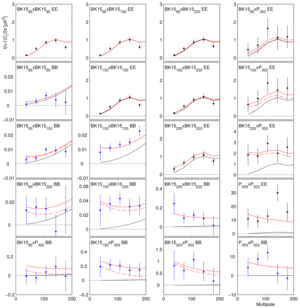 |
Figure 2: EE and BB auto- and cross-spectra calculated using BICEP2/Keck 95, 150 & 220 GHz maps and the Planck 353 GHz map. The BICEP2/Keck maps use all data taken up to and including the 2015 season—we refer to these as BK15. The black lines show the model expectation values for lensed-ΛCDM, while the red lines show the expectation values of the baseline lensed-ΛCDM+dust model from our previous BK14 analysis (r=0, Ad,353=4.3 μK2, βd=1.6, αd=-0.4), and the error bars are scaled to that model. Note that the model shown was fit to BB only and did not use the 220 GHz points (which are entirely new). The agreement with the spectra involving 220 GHz and all the EE spectra (under the assumption that EE/BB=2 for dust) is therefore a validation of the model. (The dashed red lines show the expectation values of the lensed-ΛCDM+dust model when adding strong spectral decorrelation of the dust pattern—see Appendix F of BK-X for further information.) | PDF / PNG |
| Noise spectra and effective sky fraction | 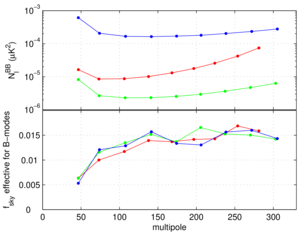 |
Figure 3: Upper: The noise spectra of the BK15 maps for 95 GHz (red), 150 GHz (green) and 220 GHz (blue) after correction for filtering of the signal which occurs due to beam roll-off and timestream filtering. (Note that no ℓ2 scaling is applied.) Lower: The effective sky fraction as calculate from the ratio of the mean noise realization bandpowers to their fluctuation, i.e. the observed number of B-mode degrees of freedom divided by the nominal full-sky number. The turn-down at low ℓ is due to mode loss to the timestream filtering and matrix purification. |
PDF / PNG |
| Baseline likelihood analysis |  |
Figure 4: Results of a multicomponent multi-spectral likelihood analysis of BICEP2/Keck+WMAP/Planck data. The red faint curves are the baseline result from the previous BK14 paper (the black curves from Fig. 4 of that paper). The bold black curves are the new baseline BK15 results. Differences between these analyses include adding Keck Array data taken during the 2015 observing season, in particular doubling the 95 GHz sensitivity and adding, for the first time, a 220 GHz channel. (In addition the ε prior is modified.) The upper limit on the tensor-to-scalar ratio tightens to r0.05 < 0.072 at 95% confidence. The parameters Ad and Async are the amplitudes of the dust and synchrotron B-mode power spectra, where β and α are the respective frequency and spatial spectral indices. The correlation coefficient between the dust and synchrotron patterns is ε. In the β, α and ε panels the dashed lines show the priors placed on these parameters (either Gaussian or uniform). | PDF / PNG |
| r vs ns constraint | 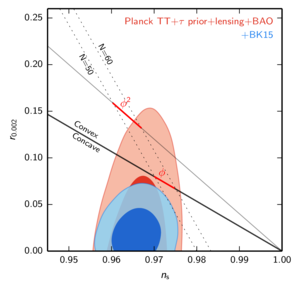 |
Figure 5: Constraints in the r vs. ns plane when using Planck plus additional data, and when also adding BICEP2/Keck data through the end of the 2015 season—the constraint on r tightens from r0.05<0.06. This figure is adapted from Fig. 21 of Planck Collaboration 2015 XIII, with two notable differences: switching lowP to lowT + a τ prior of 0.055±0.009 (Planck intermediate results XLVI) and the exclusion of JLA data and the H0 prior. | PDF / PNG |
| Noise vs. frequency | 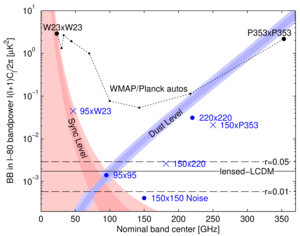 |
Figure 6: Expectation values and noise uncertainties for the ℓ∼80 BB bandpower in the BICEP2/Keck field. The solid and dashed black lines show the expected signal power of lensed-ΛCDM and r0.005 = 0.05 & 0.01. Since CMB units are used, the levels corresponding to these are flat with frequency. The blue/red bands show the 1 and 2σ ranges of dust and synchrotron in the baseline analysis including the uncertainties in the amplitude and frequency spectral index parameters (Async,23, βs and Ad,353, βd). The BICEP2/Keck auto-spectrum noise uncertainties are shown as large blue circles, and the noise uncertainties of the WMAP/Planck single-frequency spectra evaluated in the BICEP2/Keck field are shown in black. The blue crosses show the noise uncertainty of selected cross-spectra, and are plotted at horizontal positions such that they can be compared vertically with the dust and sync curves. | PDF / PNG |
| 95 GHz maps |  |
Figure 7: T, Q, U maps at 95 GHz using data taken by two receivers of Keck Array during the 2014 & 2015 seasons—we refer to these maps as BK1595. The left column shows the real data maps with 0.25° pixelization as output by the reduction pipeline. The right column shows a noise realization made by randomly assigning positive and negative signs while coadding the data. These maps are filtered by the instrument beam (FWHM 43 arcmin), timestream processing, and (for Q & U) deprojection of beam systematics. Note that the horizontal/vertical and 45° structures seen in the Q and U signal maps are expected for an E-mode dominated sky. | PNG |
| 150 GHz maps | 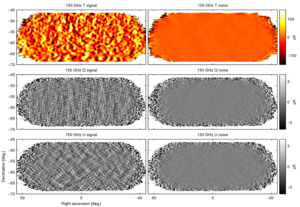 |
Figure 8: T, Q, U maps at 150 GHz using all BICEP2/Keck data up to and including that taken during the 2015 observing season—we refer to these maps as BK15150. These maps are directly analogous to the 95 GHz maps shown in Fig. 7 except that the instrument beam filtering is in this case 30 arcmin FWHM. | PNG |
| 220 GHz maps |  |
Figure 9: T, Q, U maps at 220 GHz using data taken by two receivers of Keck Array during the 2015 season—we refer to these maps as BK15220. These maps are directly analogous to the 95 GHz maps shown in Fig. 7 except that the instrument beam filtering is in this case 20 arcmin FWHM. | PNG |
| 95 GHz jackknife histograms |  |
Figure 10: Distributions of jackknife χ2 and χ PTE values for the Keck Array 2014 & 2015 95 GHz data over the tests and spectra given in Table I of BK-X. This figure is analogous to Fig. 12 of BK-VI. | PDF / PNG |
| 220 GHz jackknife histograms |  |
Figure 11: Distributions of jackknife χ2 and χ PTE values for the Keck Array 2015 220 GHz data over the tests and spectra given in Table II of BK-X. | PDF / PNG |
| Comparison of 95 GHz BB spectra | 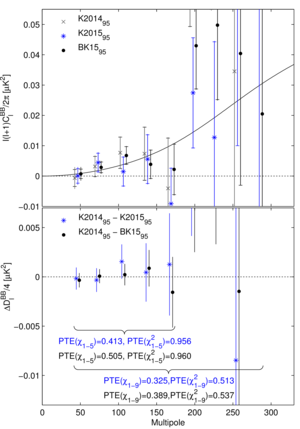 |
Figure 12: Upper: Comparison of the 95 GHz BB auto-spectrum as previously published (K201495), for 2015 alone (K201595), and for the combination of the two (BK1595). The inner error bars are the standard deviation of the lensed-ΛCDM+noise simulations, while the outer error bars include the additional fluctuation induced by the dust signal. Note that neither of these uncertainties are appropriate for comparison of the band power values—for this see the lower panel. (For clarity the sets of points are offset horizontally.) Lower: The difference of the pairs of spectra shown in the upper panel divided by a factor of four. The error bars are the standard deviation of the pairwise differences of signal+noise simulations which share common input skies (the simulations used to derive the outer error bars in the upper panel). Comparison of these points with null is an appropriate test of the compatibility of the spectra, and the PTE of χ and χ2 are shown. This figure is similar to Fig. 13 of BK-VI. |
PDF / PNG |
| All BB auto- and cross-spectra | 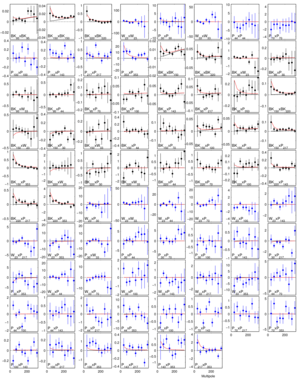 |
Figure 13: The full set of BB auto- and cross-spectra from which the joint model likelihood is derived. In all cases the quantity plotted is 100ℓCℓ/2π (μK2). Spectra involving BICEP2/Keck data are shown as black points while those using only WMAP/Planck data are shown as blue points. The black lines show the expectation values for lensed-ΛCDM, while the red lines show the expectation values of the maximum likelihood lensed-ΛCDM+r+dust+synchrotron model (r=0.020, Ad,353=4.7 μK2, βd=1.6, αd=-0.58, Async,23=1.5 μK2, βs=-3.0, αs=-0.27, ε=-0.38), and the error bars are scaled to that model. | PDF / PNG |
| BB spectral decomposition | 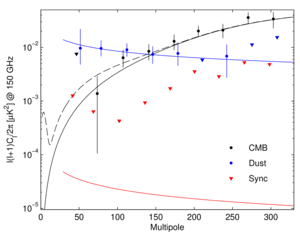 |
Figure 14: Spectral decomposition of the BB data into synchrotron (red), CMB (black) and dust (blue) components at 150 GHz. The decomposition is calculated independently at each bandpower, marginalizing over βd, βs and ε with the same priors as the baseline analysis. Error bars denote 68% credible intervals, with the point marking the most probable value. If the 68% interval includes zero, we also indicate the 95% upper limit with a downward triangle. (For clarity the sets of points are offset horizontally.) The solid black line shows lensed-ΛCDM with the dashed line adding on top an r0.005=0.02 tensor contribution. The blue/red curves show dust/sync models consistent with the baseline analysis (Ad,353=4.6 μK2, βd=1.6, αd=-0.4 and Async,23=1.0 μK2, βs=-3.1, αs=-0.6 respectively). | PDF / PNG |
| Likelihood evolution |  |
Figure 15: Evolution of the BK14 analysis to the “baseline” analysis as defined in BK-X—see Appendix E1 for details. | PDF / PNG |
| Likelihood analysis variations |  |
Figure 16: Likelihood results when varying the analysis choices—see Appendix E2 for details. | PDF / PNG |
| Likelihood including lensing amplitude |  |
Figure 17: Likelihood results when allowing the lensing amplitude to be a free parameter—see Appendix E2 for details. | PDF / PNG |
| Likelihood data set variations |  |
Figure 18: Likelihood results when varying the data set selection—see Appendix E2 for details. | PDF / PNG |
| Likelihood curves for simulations |  |
Figure 19: Left: Likelihood curves for r when running the baseline analysis on each of the lensed-ΛCDM+dust+noise simulations—half of them peak at zero. The real data curve is shown overplotted in heavy black. Right: The CDF of the zero-to-peak ratio (red) of the curves shown at right as compared to the simple analytic ansatz (solid black) ½ (1-f (-2 log L0/Lpeak)) where f is the χ2 CDF (for one degree of freedom). About one fifth of the simulations offer more evidence for non-zero r than the real data when the true value is actually zero (dashed black). |
PDF / PNG |
| Likelihood validation |  |
Figure 20: Results of a validation test running maximum likelihood search on simulations of a lensed-ΛCDM+dust+noise model with no synchrotron (Ad,353=3.75 μK2, βd=1.6, αd=-0.42, Async=0). The baseline priors are applied on βd, βs, αd, αs and ε. The blue histograms are the recovered maximum likelihood values with the red lines marking their means and the black lines showing the input values. In the left panel σ(r)=0.020. See Appendix E3 for details. | PDF / PNG |
| Likelihood with dust decorrelation |  |
Figure 21: Likelihood results when allowing dust decorrelation—see Appendix F for details. | PDF / PNG |
| Validation for likelihood with decorrelation |  |
Figure 22: Validation tests running the likelihood with the dust decorrelation parameter Δd included. Upper row: Results for the same lensed-ΛCDM+dust+noise simulations shown in Fig. 20. Lower row: Results for the toy highly decorrelated dust model. The blue histograms are the recovered maximum likelihood values with the red lines marking their means and the black lines showing the input values. See Appendix F for details. |
PDF / PNG |
| Cross-spectra of lensing reconstructions | 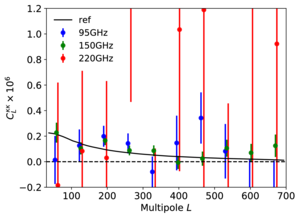 |
Figure 23: Cross-correlation of the lensing reconstructions between Planck and BK15. We show the spectra for reconstructions using the BK15 95 GHz, 150 GHz and 220 GHz bands. The black solid line shows the theoretical lensing power spectrum. | PDF / PNG |
History
- 2018-09-20: Posted BK-X: Constraints on Primoridal Gravitational Waves using Planck, WMAP, and New BICEP2/Keck Observations through the 2015 Season figures.